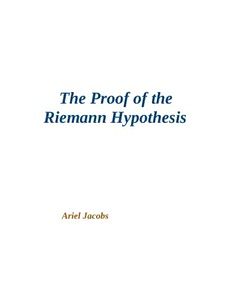
The Proof of the Riemann Hypothesis PDF
Preview The Proof of the Riemann Hypothesis
The Proof of the Riemann Hypothesis Ariel Jacobs The distribution of the zeros of the Riemann zeta function outside of the critical strip has already been comprehensively identified and proved to be such. If s is a complex number that will be used as an input to the Riemann zeta function, then to prove the Riemann Hypothesis, we need only consider values of s within the critical strip, meaning that 0 < Re(s) < 1. Furthermore, due to the known behavior of the zeta function over the critical strip within the approximate range of -12 ≤ Im(s) ≤ 12, we need only consider values of s such that Im(s) < -12 and Im(s) > 12. Therefore, the rest of our discussion will always and only refer to values of s within the critical strip such that Im(s) < -12 or Im(s) > 12. We will designate Re(s) as α, and Im(s) as β. Therefore s = α + (β)i, where i is the imaginary unit. By convention, we will identify the Riemann zeta function with the lowercase Greek Zeta, the Riemann Xi function with the lowercase Greek Xi, and the Gamma function with the uppercase Greek Gamma. * Note: The equations throughout this proof were generated using two different character styles, and consequently there are two slightly different representations of the lowercase Greek letter Zeta, but both representations refer to the same function: the Riemann zeta function. Equation (1) is the equation for the Riemann Xi function. Equation (2) is the reflection formula for the Riemann Xi function. Equation (3) shows what we get when we replace s with (1 – s) in the Riemann Xi function. Because of the reflection formula in Equation (2), we can set the right side of equation (1) equal to the right side of equation (3) to give us equation (4). Let us define a new function H(s) with equation (5). As you can see from equations (5) and (4), we have defined H(s) such that we get equation (6). An analysis of H(s) over the critical strip will show that H(s) will never be equal to zero. Therefore, you can see from equation (6) that if ζ(s) = 0, then ζ(1 - s) = 0. The symmetry of the Riemann zeta function is such that equation (7) is true. A consequence of this symmetry is that if ζ(s) = 0, then For that same reason, if ζ(1 - s) = 0, then So far, we have shown that if ζ(s) = 0, then equation (8) must be true. For the remainder of the proof, we will assume that ζ(s) = 0. Equation (9) is the functional equation for the Riemann zeta function. Let us define a new function F(s) with equation (10). As you can see from equations (10) and (9), we have defined F(s) such that we get equation (11). Using equation (8), we can replace ζ(1 – s) in equation (11) with to give us equation (12). We can rearrange equation (12) to give us equation (13). Equation (14) is the reflection formula for the Riemann zeta function. Let us define a new function G(s) with equation (15). As you can see from equations (15) and (14), we have defined G(s) such that we get equation (16). By replacing s in equation (16) with , we get equation (17). By evaluating the input expression of , we can see that equation (18) is true. Because of equation (8), we also know that Referring to equation (17), and using equations (18) and (8), we can replace with and replace with to give us equation (19). We can then rearrange equation (19) to give us equation (20). Because both and , we cannot claim that must be true. However, we can claim that equation (21) must be true. We can use equations (20) and (13) to rewrite equation (21) as equation (22). We can use equations (15) and (10) to rewrite equation (22) as equation (23). Therefore, EQUATION (23) MUST BE TRUE IF ζ(s) = 0. An analysis of the left side of equation (23) over the critical strip such that β < -12 and β > 12 will show that FOR ALL BUT ONE value of α, the left side of the equation NEVER equals 1. There is only one value of α over the critical strip for which equation (23) is true, and that value is ½. When α = ½, equation (23) is true for EVERY value of β. This proves BOTH that all zeros of the Riemann zeta function over the critical strip MUST have a real part equal to ½, AND that it is possible for the Riemann zeta function to have infinitely many zeros with a real part equal to ½. We proved two facts. The first fact is the Riemann Hypothesis. It has been proven previous to this paper that there are infinitely many zeros of the Riemann zeta function with a real part equal to ½. The fact that equation (23) is true for all values of β when α = ½ is the underlying reason that it’s possible for there to exist infinitely many zeros with α = ½. Thanks for your time. To read my paper on using the principle of least action to discover the most efficient deterministic method for solving the Travelling Salesman Problem, click on the link below. https://drive.google.com/open?id=1iE1BREHnZ2Tfpkt39AdvpvsQm2c7eBmy
